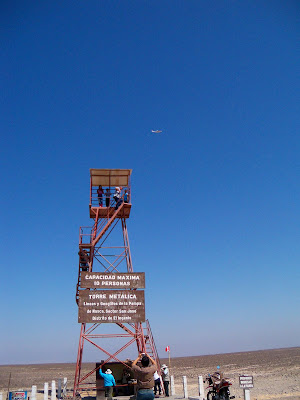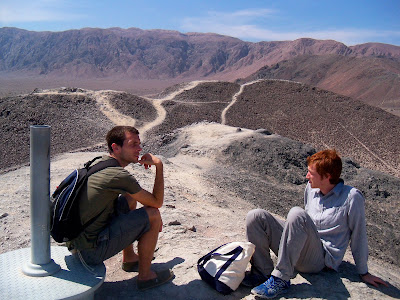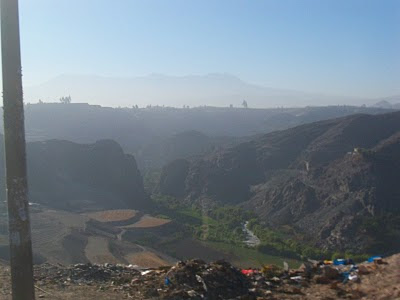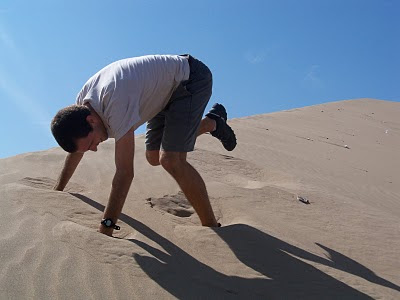
--------------------
The best shot I got of Colca Canyon-----------------
While in Arequipa, we popped into a few a few of the shops that offered tours to Colca Canyon. This great rift through the Andean highlands is in fact twice as deep as the Grand Canyon and is the second deepest canyon in the world. The holder of that distinction would be Cañon del Cotahuasi, which is only a few hundred miles away and merely a few hundred meters deeper. Cotahuasi is also a lot harder to get to and we weren't in the mood to sink a day into the bumpy ride out there over obscure roads.
Where we were, the canyon depth was probably only three-thousand feet up, though at the rim we were probably close to 12,000 feet above sea level--high enough so that altitude was no joke and had potentially unpleasant consequence for the unacclimatized
Colca Canyon, was up to then, the most beautiful place that I had ever seen. The rock walls of basalt and other minerals plunged down to the sparkling turquoise river below. The natural environment in and around the canyon varies from alpine desert near the top to edenic stands of trees and cactii that grew near the bottom. Even cooler, it was home to the Andean Condor. We saw these big, graceful birds slipping along the thermals at Cruz del Condor--along with two hundred other tourists shooting them out of the sky with their digital cameras. After we had left this popular, however, we still got a few views of condors as well as hawks.
Had my camera been working, I would have had a photographic field day. Unfortunately, the sand that had slipped into the workings at Huacachina had put my camera in an ornery mood. Now, the lens was permanently out of focus, and I could only take blurred out drunken snapshots of the awesome majesty around me. I was furious at myself for the earlier clumsiness, but at least Max had a camera, so it was not a total loss.
What was particularly inspiring to me was that even in it's rugged isolation, the canyon had held people, societies that went back thousands of years. Today, people still inhabit small towns built by the Spanish. Our hike led us through these villages where people still spoke their native languages, including Quechua and Aymara. Present day farmers still used the ancient infrastructure of terraces and aquaducts.
I must be careful not to enter the territory of cliché if I get overly romantic about the simple, harmonious arrangement that the locals lived in. It is important to note that it is still pretty common for people to move out of the canyon for their education, jobs and the like. Cement and tin-roofed huts suggested that there wasn't much money to go around.
Still, I saw an austere beauty to it all. They had obviously manipulated the local ecosystem with their irrigation ditches and livestock, but trees and cactii were still in abundance. There was also far less litter on the ground than what I had seen in the citiies, none of the desperate sprawl that I had seen in Lima and Nazca. People along the trails included several post card-ready local women adorned in colorful robes. Some of them sold bottled water and soda to thirsty foreigners but even where there was no opportunity for them to gain from us economically, they remained incredibly warm to the visitors to their canyon. When we passed someone along the trail, we were sure to get a smile and a "buenas tardes."
The day we would leave Arequipa for Colca, we had to set an alarm 3:00 in the morning in order to make the tour, which was supposed to pick us up at the hostel. We lurched out of our bunks, gathered our packs in the cold darkness and walked down the hall to some chairs by the door where we could wait.
We jumped up at the sound of the doorbell, but when I unlatched the entrance, it turned out just to be some German guy coming back from the clubs. It was now 3:30 and we were starting to worry about our tour showing up. The bell rang again--only this time it was a Scottish guy. He seemed fairly awake and aware considering the circumstances. When he saw our group sitting around waiting, he decided to sit with us and shoot the breeze for a while.
At last, the actual tour guide knocked on the door and lead us out to the street where a minibus full of other passengers was idling. We tossed our packs in the back, and got our sat down in the last row of seats.
Sleep-deprived as I was, it was almost impossible to drift back off. Instead, I watched as the Arequipa suburbs went by and the bus began to climb up along a windy mountain highway. The stars became vivd as we left the town limits and then filled the sky with so much detail that it made my mind hurt to keep them all within my gaze. The moon was a tiny sliver, making the contrast off the heavens against the darkness of space all the more striking. I could dimly perceive the hulking stone outlines of cliffs to our right; to the left, the dim twinkle of the city dropping away as we climbed. The breath of all the passengers formed a layer of frost on my window which I had to scratch away in order to continue watching outside. It was worth it because I managed to spot two shooting stars.
In a surreal moment, the bus went by a burning truck. Its breaks must have failed coming down the hill and it was now blazing heartily along the roadside. A group of men stood outside the catastrophe like a group of boy scouts at a campfire.
Meanwhile, it became obvious that with each switchback going by, the van was gaining some serious altitude. At around 15,000 feet, the bus reached a flat wasteland of scrub and rock. The rising sun illuminated the gray landscape patched over by frost and frozen pools of water. It was all incredibly beautiful.
My ears had popped several times during the climb. More amusing, Ben's bag of Oreos from Arequipa had swollen up like a balloon in the lower air-pressure. I felt like I was breathing a little harder, but because I was sitting still, the effect on me was not so great. Once I got out to move around, I could tell that ordinary physical effort had got a lot harder.
Ben and I had been hydrating regularly to counteract the lower oxygen but soon found ourselves thinking less about air pressure and more about bladder pressure. Finally, we got the driver to stop and scrambled out and down a rocky ditch so we could relieve ourselves. I reflected that (disregarding airplanes) this was the highest altitude piss that I had taken yet. When I tried to hurry back to our ride, the ten feet of effort had me sucking wind and got the heart pounding. That's when I realized that altitude was real and that I felt it as much as anyone.
After our excursion, the bus began winding down into a lower valley. It was some of the most beautiful scenery I'd seen yet. Too bad the camera wasn't working.
The bus pulled over in Chivay, a local town so that we could have a spartan breakfast of rolls, jelly and coca tea. That's right, it's the same stuff that goes up your nose at the frat, only in its milder organic form. Here, locals consider it an altitude supplement, even though it probably has less of a kick than a cup of coffee. Since everyone knows that drugs are cool, I chugged my mug. Tasted a bit like grass clippings. I thought the coca cookies I'd brought were far tastier. I even distributed some to two British women I'd been talking to along the ride, thereby elevating my status from use to dealer.
We boarded the bus again, which took us off the paved road and onto jaw-clicking dirt. The constant rattling battered all the dust out of the seats and into our air. It was soon as dusty within the cabin as it was on the road outside.
Lots of people were asleep, but I they were missing out. Colca Canyon was on our right, a massive gap in the land surrounded by frowning rock faces. Below, there were fields of terraces built into the slopes. Special bridges built for aquaducts went over the road. At one point, the bus went through a 200 meter long tunnel so that it could cut through a slope. There were no lights within, save from the bus, and the space was filled with dust. We emerged on the other side and drove a few more bumpy miles until we arrived at Cruz del Condor.
At the crest of a rise, we could see the tourists in Peruvian knit caps and massive cameras, thronged about the clifftop like a conquering Inca army. The bus offloaded us at the side of the road and we went out along footpaths to swarms gathered around the edge. People looking down into the canyon hooted, screamed and clicked their shutters as the birds made their lazy swoops along the thermals. Many ran around recklessly without regard for the trails, mindlessly trampling over the vegetation. The whole scene was kind of disgusting, and I was glad to get back in the bus.
If we had signed up for the one day tour, Cruz Del Condor would have been the big highlight of our trip. After we got our pictures, we would have grabbed up some tourist trinkets from one of the stands and called it done. Fortunately we had had the foresight to sign up for the hike and the overnight stay, which meant that we had a chance to explore the canyon's depths while getting away from some of the hoards of people.
The van took us a couple of miles down the road to an adjoining farm path where we got out again to begin our hike. The guides split the bus into two groups. As it happened, we three Americans got the Spanish-speaking guide even though we had signed up for English. This was a surprise blessing however as we got a learning opportunity out of it. Because she spoke clearly and took the time to explain things along the trail, I got a language lesson to go with the tour. She was patient enough to wait for me to piece together my scraps of vocab into coherent questions so that I got practice in speaking as well as listening.
Ben and I took the lead for the descent until there was a French guy that went past us. The canyon's geology was eye-popping: massive basalt walls, rockfalls that had tumbled down the sides. It was extremely warm and bright. There was a wooden-decked suspension bridge at the bottom with a big sign welcoming us to the national park. The patch of shade it created was a popular piece of real-estate for resting hikers and women selling soda and bottled water laid out on blankets. We scooted in out of the sun, took off our bags and waited for the rest of our group.

---------
The river as seen through my camera from the bridge--------
Eventually everyone caught up, paid up for bottled water and soda. We crossed the bridge together and followed the path up a steep grade for about two-hundred feet until it leveled out and took a more leisurely course in the direction of the river's flow. The climate down in the canyon was mediterranean with plenty of green plant life, but also with man-made walls, steps and the aqueducts that I had mentioned earlier.
After about a half mile walk, we came into a small town for lunch on an outdoor patio. We had a German couple at our table, along with a Hungarian woman and a gaggle of French. The Hungarian and the French were roughly our age; all would be students at university in Lima in the fall. The French didn't know much English, but we could communicate with them somewhat with the limited Spanish on both sides.
The rest of the hike took us along many ups and downs, through other small canyon towns and to spectacular vistas of the high mountain walls around us. The towns were only accessible by foot or hoof for those with burros. Despite their isolation, some of them had good-sized buildings and works of stone. One had a large stone church and an event plaza. Wires supplied the homes with their electricity. I don't know for sure about internet access, but I kind of doubted it.
I was particularly impressed by the aquaducts, which rushed alongside the path in narrow concrete trenches. The waterways were everywhere, stretching up for miles to their origins in the mountains. In some places, locals had cut tunnels into the rocks to allow the water to pass through the mountainside. At another point, the trail followed the edge of a steep drop where the builders had left room for the aquaduct and not the path. In order to walk around, we had to balance carefully on the concrete curb. Looking down was optional.
Around four o'clock, we redescended into the canyon, pounding down the loose gravel trail, sending clouds of dust into the air. I waved to the brits as we fell past their group. Fast as we were hiking, some guy in running shoes without a pack came sprinting, literally sprinting, out of nowhere and flew past us. In a couple of seconds he flew around the side of a canyon wall and disappeared. I would have liked to know his story, but he wasn't going to hang around and and answer questions.
The descent ended in a bridge over the rapids and consisted of stout lumber supported by steel cables from overhead. The old girl buckled and swung quite a bit as we crossed, but unfortunately it was too wide to have the drama of a true Indiana Jones bridge.
No, we did not sleep in one of the local towns. On the other side of the bridge, there was a settlement of bamboo huts built specifically for tourists. Ben, Max and I got one with three beds, threw off our packs and chilled out for the two hours we had until dinner. Interestingly, these thatched dwellings were perfectly see-through, though I suppose there was nothing we had to hide inside our hut, so it was not a big deal. The place also had an icy spring-fed pool nearby where I refreshed myself to near hypothermia.
I got into my fleece and parka for dinner. The high heat of the day vanished with sunlight, and I relished the thought of a warm dinner alongside a steaming cup of tea. We three Americans sat with the Hungarian and the French for a long dinner inside the central pavilion. Spanish was language of choice at the table, though it was hard not to throw in English words when I got stuck trying to express my thoughts. Trying to justify vegetarianism using a second language is an interesting challenge.
After we'd scraped our plates and drank the dregs from our mugs, I stepped out afterwards to see the most striking star display ever. The southern hemisphere has a different lineup from the north and I didn't recognize anything, save Venus, which shone with the intensity of a searchlight coming over a mountain. I knew about the southern cross, but I didn't know how to look for it. The milky way appeared in such crisp detail, that I felt like I could look at it like a three dimensional object. It is crazy to think that in the days before electric light, our ancestors could look up on any clear night and see that. Maybe that's why they were so nuts.
We would get up at five o'clock the next morning to begin our ascent back to the canyon rim. I should guess that during the course of the climb, we went up about 2,500 feet. This was particularly tough going because we had rocks sliding out underneath each footfall. The effect of the altitude was palpable as well. It is hard to say how much easier our ascent would have been at lower elevation, but I'm sure that the thinner air was no help to us.
Amazingly, despite the tough conditions, I saw men and boys go running past us down the slope, chasing after fully-loaded burros. Our own hike from the base took about two hours, with Ben leading and Max and I trying to catch up.
We waited at the rim for about forty minutes for the rest of the group to catch up. After a short while waiting, I felt the warmth of the hike leave me and the sweaty t-shirt I was wearing gave me the chills. I changed into my fleece, and then put on a hat and parka. As the sun came up. a bunch of Eastern Europeans stood out in warming rays, looking cool as shit smoking their cigarettes. Actually, considering that they were smokers and had still gotten there before us, that was pretty impressive.
We hiked the rest of the way up to a small town where we had lunch and I ended up talking to the brits again. One was an art teacher and the other sold insurance. Both said that they'd found the morning's hike to be more difficult than the Inca Trail. They were both really fun, and sounded like they'd been having a grand time in Peru. Perhaps too much of a grand time based on what they told me about Arequipa.
On the way out of the canyon, our bus stopped at some hotsprings in Chivay, where I took a dip i what appeared to be a dirty swimming pool, only filled with scalding water. Some people apparently think the hot springs have medicinal properties. I agree that they could be a cheap solution for those that want to be sterilized.
Food followed swim--a twenty sole buffet lunch where the true Americans stuffed themselves with as many plates as we could fit. With the proper amount of gumption, we'd be able to get full enough to skip dinner befire we got on the bus to Cuzco.
On the way back over the pass, the Germans complained that they hadn't gotten a chance to see the alpacas and felt cheated. "So you're a liar," one of them told the guide when he told them that it was the wrong time of day for it. Eventually, he pointed out some grazing llamas as we went by. They muttered angrily that it was the wrong kind of dromedary.
The bus began climbing out the way we had came and stopped at 15.000 feet. We got out to sample the altitude, which really wasn't so bad if you weren't running. For some reason there were thousands of rock piles all around. I think it might have been a good luck thing.
It was still a few hours back to Arequipa. We had about an hour to grab our stuff and chill out before we got in a cab and off to the bus station for Cuzco.




















































